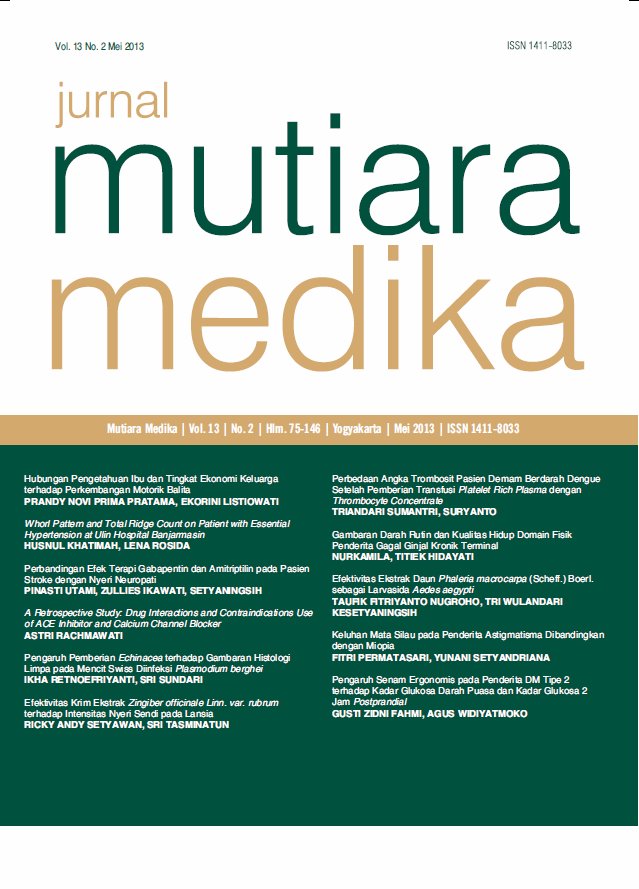Parental Practice and Problem Video Game Playing in Adolescents
DOI:
https://doi.org/10.18196/mmjkk.v13i2.1066Keywords:
video game playing, adolescent, parental practiceAbstract
The descriptive design study was conducted to describe demographic data, parental practice, and problem video game playing in adolescents. Data was collected from 224 parents and 224 adolescents who study in one primary, one secondary, and one high school in Yogyakarta municipality, Yogyakarta province, Republic of Indonesia. It was collected using parental practice in video game playing adolescents’ questionnaires and problem video game playing (PVP) scale during April to May 2013. The results showed that the majority of parents were in good practice level. Parental practice in video game playing in adolescents was at a moderate practice (18.8%, n=42) and good practice (81.2%, n=182). There were no parents in bad practice level. The majority of adolescents were non problematic playing. There were 84.4 % (n=189) non problematic playing, while 15.6% (n=35) were problematic playing.
References
American Academy of Child and Adolescent Psychiatry. Children and Video Games: Playing with Violence. Retrieved November 18, 2012 from http://www.aacap.org/cs/root/ facts_for_families/children_and_ video_ games_playing_with_violence
National Institute on Media and the Family. Video Game Addiction. Minneapolis: 2007.
Reisinger, D. 91 Percent of Kids are Gamers, Research Says. October 11, 2011. Retrieved January 14, 2013, from http://news.cnet.com/ 8301-13506_3-20118481-17/91-percent-ofkids-are-gamers-research-says/
Wei, R. Effects of Playing Violent Videogames on Chinese Adolescents’ Pro-Violence Attitudes, Attitudes Toward Others, and Aggressive Behavior. CyberPsychology&Behavior, 2007; 10(3): 371-380
Supaket, P., Munsawaengsub, C., Nanthamongkolchai, S., Apinuntavetch, S. Factors Affecting Computer Game Addiction and Mental Health of Male Adolescents in Muang District, Si Sa Ket Province. J Public Health, 2008; 38(3): 317-330.
Resnick, M.D., Bearman, P.S., & Blum, R.W. Protecting Adolescents from Harm: Findings from the national longitudinal study of adolescent health. The Journal of the American Medical Association (JAMA), 1997; 278 (10), 823831.
Nikken, P. [n.d.]. Parental Mediation of Children’s Video Game Playing: A similar Construct as Television Mediation. ASCoR University of Amsterdam. Retrieved January 16, 2013, from http://www.digra.org/dl/db/05150.50493
Blieszner, R. and Mancini, B.A. Enduring Ties: Older Adults’ Parental Role and Responsibilities. National Council on Family Relations, 1987 ; 36 (2): 176.
Thalib, M. Praktik Rasulullah Saw Mendidik Anak Bidang Akhlaq dan Pergaulan 2000. Bandung: Irsyad Baitus Salam.
Salguero, R.A.T. & Moran, R.M.B. Measuring Problem Video Game in Adolescents. Addiction, 2002; 97, 1601-1606.
Phillips, C.A., Rolls, S., Rouse, A., Griffiths, M.D. Home Video Game Playing in Schoolchildren: a Study of Incidence and Patterns of Play. Journal of Adolescence, 1995. 18: 687-691.
Srisuwan, P. Computer Game Playing, Family Functioning and Health Promotion Behavior among the School-Aged Children in Khon Kaen Municipality. Thesis of Master Student. Faculty of Nursing. Khon Kaen University. 2010.
Hauge, M.R. & Gentile, D.A. Video Game Addiction among Adolescents: Associations with Academic Performance. 2003. Retrieved November 18, 2012 from http://www.psychology. iastate.edu/faculty/dgentile/SRCD%20Video%20Game%20Addiction.pdf
Downloads
Published
Issue
Section
License
Copyright
Authors retain copyright and grant Mutiara Medika: Jurnal Kedokteran dan Kesehatan (MMJKK) the right of first publication with the work simultaneously licensed under an Attribution 4.0 International (CC BY 4.0) that allows others to remix, adapt and build upon the work with an acknowledgment of the work's authorship and of the initial publication in Mutiara Medika: Jurnal Kedokteran dan Kesehatan (MMJKK).
Authors are permitted to copy and redistribute the journal's published version of the work (e.g., post it to an institutional repository or publish it in a book), with an acknowledgment of its initial publication in Mutiara Medika: Jurnal Kedokteran dan Kesehatan (MMJKK).
License
Articles published in the Mutiara Medika: Jurnal Kedokteran dan Kesehatan (MMJKK) are licensed under an Attribution 4.0 International (CC BY 4.0) license. You are free to:
- Share — copy and redistribute the material in any medium or format.
- Adapt — remix, transform, and build upon the material for any purpose, even commercially.
This license is acceptable for Free Cultural Works. The licensor cannot revoke these freedoms as long as you follow the license terms. Under the following terms:
Attribution — You must give appropriate credit, provide a link to the license, and indicate if changes were made. You may do so in any reasonable manner, but not in any way that suggests the licensor endorses you or your use.
- No additional restrictions — You may not apply legal terms or technological measures that legally restrict others from doing anything the license permits.






